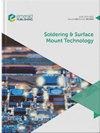超声焊接过程中Cu/Sn/Cu体系金属间化合物的组织演变及生长动力学
IF 1.7
4区 材料科学
Q3 ENGINEERING, ELECTRICAL & ELECTRONIC
引用次数: 0
摘要
目的研究不同温度下超声对金属间化合物(IMCs)界面微观结构和生长动力学的影响。设计/方法/方法为了定量研究超声对IMCs生长的影响,获得了IMCs层在确定长度上的横截面积,用于计算IMCs层的厚度。结果:超声焊点中Cu6Sn5与相邻Cu6Sn5在法向上的尺寸差异的产生,以及boss状Cu6Sn5和非界面Cu6Sn5的形成,使得界面Cu6Sn5层呈现出与传统焊点不同的非扇贝状形貌。在260℃和290℃时,Cu3Sn层呈波状。320℃时,超声波焊点中的Cu3Sn由非界面Cu3Sn和界面Cu3Sn组成,界面Cu3Sn呈枝状。超声作用下Cu6Sn5/Cu3Sn界面和Cu3Sn/Cu界面呈锯齿状。在260°C、290°C和320°C时,超声波辅助Cu6Sn5生长的主要机制是晶界扩散伴随晶粒粗化。在260°C和290°C超声焊接过程中,Cu3Sn的生长受体积扩散控制。当超声焊接温度提高到320℃时,Cu3Sn生长的扩散机制转变为晶界扩散并伴有晶粒粗化。不同温度下超声制备的超声焊点中IMCs的显微组织演变和生长动力学在以往的研究中很少有报道。本研究系统地研究了超声对IMCs微观结构演化和生长动力学的影响。本文章由计算机程序翻译,如有差异,请以英文原文为准。
Microstructures evolution and growth kinetics of intermetallic compounds in Cu/Sn/Cu system during ultrasonic soldering process
Purpose
This study aims to investigate the effect of ultrasound on interfacial microstructures and growth kinetics of intermetallic compounds (IMCs) at different temperatures.
Design/methodology/approach
To investigate the effect of ultrasound on IMCs growth quantitatively, the cross-sectional area of IMCs layers over a confirmed length was obtained for calculating the thickness of the IMCs layer.
Findings
The generation of dimensional difference in normal direction between Cu6Sn5 and its adjacent Cu6Sn5, formation of bossed Cu6Sn5 and non-interfacial Cu6Sn5 in ultrasonic solder joints made the interfacial Cu6Sn5 layer present a non-scallop-like morphology different from that of traditional solder joints. At 260°C and 290°C, the Cu3Sn layer presented a wave-like shape. In contrast, at 320°C, the Cu3Sn in ultrasonic solder joints consisted of non-interfacial Cu3Sn and interfacial Cu3Sn with a branch-like shape. The Cu6Sn5/Cu3Sn boundary and Cu3Sn/Cu interface presented a sawtooth-like shape under the effect of ultrasound. The predominant mechanism of ultrasonic-assisted growth of Cu6Sn5 growth at 260°C, 290°C and 320°C involved the grain boundary diffusion accompanied by grain coarsening. The Cu3Sn growth was controlled by volume diffusion during the ultrasonic soldering process at 260°C and 290°C. The diffusion mechanism of Cu3Sn growth transformed to grain boundary diffusion accompanied by grain coarsening when the ultrasonic soldering temperature was increased to 320°C.
Originality/value
The microstructural evolution and growth kinetics of IMCs in ultrasonically prepared ultrasonic solder joints at different temperatures have rarely been reported in previous studies. In this study, the effect of ultrasound on microstructural evolution and growth kinetics of IMCs was systematically investigated.
求助全文
通过发布文献求助,成功后即可免费获取论文全文。
去求助
来源期刊

Soldering & Surface Mount Technology
工程技术-材料科学:综合
CiteScore
4.10
自引率
15.00%
发文量
30
审稿时长
>12 weeks
期刊介绍:
Soldering & Surface Mount Technology seeks to make an important contribution to the advancement of research and application within the technical body of knowledge and expertise in this vital area. Soldering & Surface Mount Technology compliments its sister publications; Circuit World and Microelectronics International.
The journal covers all aspects of SMT from alloys, pastes and fluxes, to reliability and environmental effects, and is currently providing an important dissemination route for new knowledge on lead-free solders and processes. The journal comprises a multidisciplinary study of the key materials and technologies used to assemble state of the art functional electronic devices. The key focus is on assembling devices and interconnecting components via soldering, whilst also embracing a broad range of related approaches.
 求助内容:
求助内容: 应助结果提醒方式:
应助结果提醒方式:


